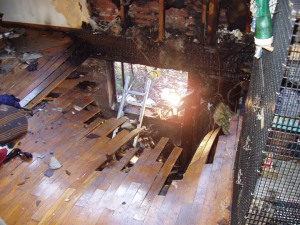Few fireman have such a natural knack for the job and the ability to mentor and inspire other firefighters, but Mick was all these things. Mark “Mick” McKenzie served as a life member of the Kentland Fire Department and held rank to the position of Deputy Fire Chief. In addition, he was a career firefighter in Montgomery County, Maryland serving at various firehouses such as Rockville, Wheaton, and Takoma Park.
Mick had just enough quirks to make you want to listen to him. He was up so much he fell asleep constantly, in the most random of places – usually with a cigarette in his mouth. One night, he was in charge of TL-33 and we were returning from a AFA around 0200hrs. I was a newly hired career firefighter and I was tired and worried about getting to work at my normal time in the AM…. Mick made us stop at 3 different 7-Elevens so he could find the right flavor Slushee to mix with his soda. On another night, he kept me and some other guys up till 0430hrs teaching us about locks.
Mick performed flawlessly on the fireground. He was the epitome of “first in, last out” and always had something to show you or teach you. He was the type of guy who inspired you to shut up and listen whenever he said anything – it was a privilege for him to just to take time to talk to you. He had a “can do” attitude and made sure you had it too. Cited countless times by numerous organizations for his herosim, ingenuity, and valor, Mick was well known in the metro-DC area fire service.
He passed away yesterday, August 15, 2008 in Frederick, MD.
Mick represents another lost from what seems to be a dying stock of “inspirational firefighters”. His career and his teachings should inspire all of us to do what he did best – inspire others. Don’t waste the resources around you. There are a lot of phenominal firefighters out there. You might not recognize it immediatley, but some of them could be standing right next to you. Take time, every day, to learn from others and to share with others what you know.
Thats what Mick taught me.
Filed under: Company News | 2 Comments »
 Over the next week or so, a few of our instructors will each post a little about what they have in their pockets and why… As a bit of background, I work in a diverse neighborhood of Washington, DC and spend most of my time on a ladder company, with an occasional detail to an engine. We have a few good neighborhoods, but many are not. We run a variety of building types: from ranchers to old victorians, multi-story walkup tenements, taxpayers, garden apartments, etc.
Over the next week or so, a few of our instructors will each post a little about what they have in their pockets and why… As a bit of background, I work in a diverse neighborhood of Washington, DC and spend most of my time on a ladder company, with an occasional detail to an engine. We have a few good neighborhoods, but many are not. We run a variety of building types: from ranchers to old victorians, multi-story walkup tenements, taxpayers, garden apartments, etc.

































